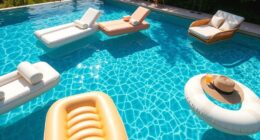To handle evaporation in your infinity pool, install a high-quality pool cover when not in use to block sun and wind. Use windbreaks like fences or trees to reduce air movement and add shade structures to minimize sunlight exposure. Maintain proper water levels and keep chemical balances steady to prevent unnecessary loss. Incorporate water features carefully and regularly inspect all components. If you want tips on optimizing your pool’s efficiency, continue exploring key strategies.
Key Takeaways
- Use a fitted pool cover to minimize exposure to air, sunlight, and wind, significantly reducing evaporation.
- Install windbreaks or barriers around the pool to block airflow and lower water vapor loss.
- Incorporate shade structures or evaporation-resistant liners to limit sunlight exposure and vapor transfer.
- Maintain proper water levels with automatic levelers to compensate for evaporation and prevent structural strain.
- Regularly inspect and maintain pool components and seals to prevent leaks and optimize water retention.
Understanding the Causes of Evaporation in Infinity Pools

Evaporation in infinity pools occurs primarily because water molecules at the surface gain enough energy from environmental factors to escape into the air. Sunlight heats the water, increasing the molecules’ energy and making it easier for some to break free. Wind also plays a role by removing the humid air directly above the pool, which encourages more water to evaporate. Additionally, lower humidity levels in the surrounding environment mean the air can absorb more moisture, speeding up evaporation. Temperature fluctuations between day and night can cause periodic increases in evaporation rates. Understanding these causes helps you recognize that factors like sunlight, wind, humidity, and temperature all contribute to water loss. Knowing this allows you to better manage and plan for evaporation in your infinity pool. Proper cost considerations and maintenance planning can help mitigate long-term water loss and associated expenses.
Installing a Pool Cover for Reduced Water Loss

Installing a pool cover is one of the most effective ways to minimize water loss in your infinity pool. A cover reduces evaporation by limiting exposure to air and sunlight, which are primary factors in water loss. Choose a cover designed for your pool size and shape for maximum efficiency. Proper installation ensures the cover fits snugly, creating a barrier against wind and debris. Using a quality cover consistently can substantially cut down water loss, saving you both resources and maintenance time. Additionally, selecting a cover with water-resistant properties can further enhance its effectiveness in maintaining water levels.
Using Windbreaks and Barriers to Minimize Air Movement

When you create windbreaks and barriers around your infinity pool, you considerably reduce air movement that accelerates water evaporation. Installing fences, hedges, or screens blocks the wind’s force, keeping the air around the water calmer. This calmer environment decreases the rate at which water molecules escape into the atmosphere. You can use natural barriers like trees or shrubs, or install man-made structures such as lattice panels or wind curtains. Position these barriers strategically to shield the pool from prevailing winds without obstructing views or airflow essentials. Keep in mind, the goal is to slow air movement without creating stagnant air pockets. Proper placement and height of your windbreaks will optimize their effectiveness, helping you conserve water and maintain your pool’s level longer. Additionally, understanding trailer music techniques can inspire creative ways to design your barriers to blend seamlessly with your outdoor aesthetic.
Maintaining Proper Water Levels and Chemical Balance

You’ll want to regularly test your water to guarantee the pH, chlorine, and alkalinity levels stay balanced. Automatic water levelers can help maintain consistent levels as evaporation occurs, reducing the need for constant monitoring. Keeping these in check prevents issues like cloudiness or corrosion, ensuring your pool stays inviting and safe. Additionally, monitoring air quality around your pool area can help identify potential airborne contaminants that might affect water chemistry.
Regular Water Testing
How often should you test your infinity pool’s water? Ideally, you check the water at least twice a week, especially during hot weather or heavy use. Regular testing guarantees your water’s chemical balance and levels are correct. Here are four key steps:
- Use a reliable test kit to measure pH, chlorine, alkalinity, and stabilizer levels.
- Adjust chemicals promptly to maintain the recommended ranges.
- Record your test results for future reference and trend analysis.
- Re-test after adding chemicals or making adjustments to confirm proper balance.
Consistent testing helps prevent issues caused by evaporation, such as algae growth or corrosion. Staying vigilant keeps your pool inviting, safe, and well-maintained.
Automatic Water Levelers
Automatic water levelers are essential tools for maintaining consistent water levels in infinity pools, especially since evaporation can cause rapid drops. They automatically detect water level changes and add water as needed, ensuring your pool stays balanced. This helps prevent damage to the pool’s structure and keeps chemical levels steady. You can choose from various types, like float-based or sensor-based systems, depending on your setup. Proper installation is key for effectiveness. Consider this table to understand common features:
| Feature | Benefit | Example |
|---|---|---|
| Sensor Activation | Precise water level detection | Maintains steady water height |
| Automatic Refilling | Reduces manual checks | Saves time and effort |
| Compatibility | Fits different pool sizes | Versatile for various setups |
| Durability | Long-lasting performance | Resistant to pool chemicals |
| Ease of Use | Simple operation | User-friendly interface |
Additionally, choosing a reliable system can help ensure consistent performance over time.
Incorporating Water Features and Accessories Strategically

Incorporating water features and accessories thoughtfully can especially enhance the functionality and aesthetic appeal of your infinity pool. Properly chosen features can also help mitigate evaporation effects. Consider these ideas:
- Fountains or jets: Create movement and aeration, reducing stagnation and helping circulate water.
- Lighting: Strategically placed LED lights improve visibility and add ambiance, encouraging more frequent use.
- Decorative stones or plants: Integrate natural elements to stabilize edges and reduce water splashing or splattering.
- Pool covers and screens: Use semi-permanent or decorative covers to minimize water loss during off-hours without sacrificing style.
- Smart technology integration: Modern water features can include automatic controls that optimize water circulation and evaporation reduction, ensuring efficient pool maintenance.
Select features that complement your pool’s design while serving practical evaporation-reducing purposes.
Monitoring and Adjusting Water Levels Regularly

Because evaporation can cause water levels to fluctuate unexpectedly, it’s essential to monitor and adjust your infinity pool’s water regularly. Check the water level at least once a week, especially during hot or windy days when evaporation speeds up. Use a waterproof marker or a water level indicator to track changes easily. If the water drops below the ideal level, add water promptly to prevent damage to the pool’s structure and equipment. Keep a supply of clean, fresh water nearby for quick top-ups. Regular monitoring ensures you catch evaporation losses early, maintaining the pool’s aesthetic appeal and functionality. Staying vigilant about water levels helps you avoid costly repairs and keeps your infinity pool looking stunning year-round. Additionally, understanding water evaporation can help you implement more effective maintenance strategies.
Implementing Evaporation-Resistant Pool Technologies

To effectively combat water loss from evaporation, you can adopt innovative pool technologies designed to minimize the amount of water that escapes into the air. These solutions help keep your infinity pool full and reduce maintenance costs.
Adopt innovative pool solutions to reduce evaporation, conserve water, and lower maintenance costs efficiently.
Here are some effective options:
- Floating Covers: Use lightweight covers that float on the water’s surface, reducing evaporation when the pool isn’t in use.
- Shade Structures: Install retractable canopies or pergolas to block direct sunlight, lowering water temperature and evaporation rates.
- Windbreaks: Position screens or barriers around the pool to reduce wind flow, which accelerates evaporation.
- Evaporation-Resistant Liners: Opt for specially designed liners that minimize water vapor transfer through the pool surface.
Implementing these technologies helps you conserve water and maintain your pool efficiently.
Routine Maintenance and Inspection for Optimal Efficiency

Regular maintenance and inspection are essential to keep your infinity pool running at peak efficiency. You should regularly check water levels and top up as needed to compensate for evaporation losses. Inspect the pool’s filtration system and pumps to ensure they operate smoothly and efficiently. Clean filters frequently to prevent clogs that could reduce circulation and increase evaporation. Examine the pool’s surface and edges for leaks or cracks that might contribute to water loss. Test water chemistry regularly to maintain proper pH and sanitizer levels, which help prevent algae growth and keep evaporation in check. Keep an eye on the pool cover and its seals to ensure they’re functioning correctly. Routine inspections help catch issues early, saving you money and ensuring your pool stays inviting and well-maintained. Maximizing space and organization techniques can also make your pool area more functional and enjoyable.
Frequently Asked Questions
How Does Ambient Temperature Affect Evaporation Rates in Infinity Pools?
Higher ambient temperatures increase evaporation rates in your infinity pool. When the air is warmer, it causes the water surface to lose more moisture into the air. On hot days, you’ll notice the water level drops faster, so you need to top it off regularly. To minimize evaporation, consider using a pool cover when you’re not swimming, especially during peak heat, to help keep the water temperature steady and conserve water.
Can Specific Types of Pool Finishes Reduce Water Loss?
Yes, certain pool finishes can help reduce water loss. Choose smooth, non-porous surfaces like glass beads or pebble finishes, which minimize evaporation by creating a tighter seal on the pool’s surface. Additionally, darker finishes absorb heat, lowering evaporation rates. You should consult with your pool professional to select the best finish suited for your climate and pool design, ensuring ideal water conservation and durability.
What Is the Impact of Pool Size and Shape on Evaporation?
Your pool’s size and shape directly influence evaporation rates. Larger pools have more water surface area, increasing evaporation, while smaller pools lose less water. An irregular shape with more edges and curves can also boost evaporation due to increased surface exposure. To minimize water loss, consider covering your pool when not in use, especially if it has a large surface area or complex shape, and optimize wind protection around the pool.
Are There Eco-Friendly Methods to Minimize Evaporation?
Think of evaporation as a sneaky thief stealing your pool’s water. To fight back, you can install a pool cover when not in use, which acts like a shield protecting your water. Use eco-friendly products that reduce the need for frequent refills, and add shade structures or trees nearby to lower temperature and evaporation. These green tactics help conserve water while keeping your infinity pool pristine.
How Do Seasonal Changes Influence Evaporation Management Strategies?
Seasonal changes considerably impact evaporation management in your infinity pool. During hot, dry summers, you’ll notice increased evaporation, so you should lower water levels, cover the pool when not in use, and consider eco-friendly evaporation retardants. In cooler, more humid seasons, evaporation slows, so you can reduce covers and monitoring. Adjusting your strategies seasonally helps conserve water efficiently and maintains your pool’s ideal condition year-round.
Conclusion
Think of your infinity pool as a mirror reflecting balance and harmony. By managing evaporation, you’re safeguarding this tranquil haven from life’s inevitable loss. Each step you take—covering, windbreaks, monitoring—acts as a guardian, preserving its clarity and serenity. When you care for your pool, you’re tending to a symbol of calm amidst chaos. Keep this balance, and your infinity pool will remain a timeless retreat, a mirror of your dedication and peace.









